Copper
Overview
Copper (Template:PronEng) is a chemical element with the symbol Cu (Template:Lang-la) and atomic number 29. It is a ductile metal with excellent electrical conductivity, and finds extensive use as an electrical conductor, heat conductor, as a building material, and as a component of various alloys.
Copper is an essential trace nutrient to all high plants and animals. In animals, including humans, it is found primarily in the bloodstream, as a co-factor in various enzymes, and in copper-based pigments. However, in sufficient amounts, copper can be poisonous and even fatal to organisms.
Copper has played a significant part in the history of mankind, which has used the easily accessible uncompounded metal for thousands of years. Civilizations in places such as Iraq, China, Egypt, Greece, India and the Sumerian cities all have early evidence of using copper. During the Roman Empire, copper was principally mined on Cyprus, hence the origin of the name of the metal as Cyprium, "metal of Cyprus", later shortened to Cuprum. A number of countries, such as Chile and the United States, still have sizable reserves of the metal which are extracted through large open pit mines. High demand relative to supply has caused a price spike in the 2000s.
History
Copper, as native copper, is one of the few metals to naturally occur as an uncompounded mineral. Copper was known to some of the oldest civilizations on record, and has a history of use that is at least 10,000 years old. A copper pendant was found in what is now northern Iraq that dates to 8700 BC. By 5000 BC, there are signs of copper smelting, the refining of copper from simple copper compounds such as malachite or azurite. Among archaeological sites in Anatolia, Çatal Höyük (~6000 BC) features native copper artifacts and smelted lead beads, but no smelted copper. But Can Hasan (~5000 BC) had access to smelted copper; this site has yielded the oldest known cast copper artifact, a copper mace head.

Copper smelting appears to have been developed independently in several parts of the world. In addition to its development in Anatolia by 5000 BC, it was developed in China before 2800 BC, in the Andes around 2000 BC, in Central America around 600 AD, and in West Africa around 900 AD.[1] Copper is found extensively in the Indus Valley Civilization by the 3rd millennium BC.[2] In Europe, Ötzi the Iceman, a well-preserved male dated to 3200 BC, was found with a copper-tipped axe whose metal was 99.7% pure. High levels of arsenic in his hair suggest he was involved in copper smelting. There are copper and bronze artifacts from Sumerian cities that date to 3000 BC, and Egyptian artifacts of copper and copper-tin alloys nearly as old. In one pyramid, a copper plumbing system was found that is 5000 years old. The Egyptians found that adding a small amount of tin made the metal easier to cast, so bronze alloys were found in Egypt almost as soon as copper was found. In the Americas production in the Old Copper Complex, located in present day Michigan and Wisconsin, was dated back to between 6000 to 3000 BC.[3]
By 2000 BC, Europe was using copper-tin alloys or bronze. The use of bronze became so pervasive in a certain era of civilization (approximately 2500 BC to 600 BC in Europe) that it has been named the Bronze Age. The transitional period in certain regions between the preceding Neolithic period and the Bronze Age is termed the Chalcolithic ("copper-stone"), with some high-purity copper tools being used alongside stone tools. Brass was known to the Greeks, but only became a significant supplement to bronze during the Roman empire.

In Greek the metal was known by the name chalkos (χαλκός). Copper was a very important resource for the Romans, Greeks and other ancient peoples. In Roman times, it became known as aes Cyprium (aes being the generic Latin term for copper alloys such as bronze and other metals, and Cyprium because so much of it was mined in Cyprus). From this, the phrase was simplified to cuprum and then eventually Anglicized into the English copper. Copper was associated with the goddess Aphrodite/Venus in mythology and alchemy, owing to its lustrous beauty, its ancient use in producing mirrors, and its association with Cyprus, which was sacred to the goddess.
Britain and Ireland
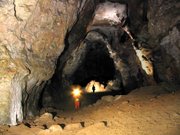
During the Bronze Age, copper was mined in Britain and Ireland mainly in the following locations:
- South West County Cork
- West Wales (e.g. Cwmwystwyth)
- North Wales (e.g. Great Orme)
- Anglesey (Parys Mountain)
- Cheshire (Alderley Edge)
- The Staffordshire Moorlands (e.g. Ecton Mine)
- Isle of Man, which is between England and Northern Ireland
At Great Orme in North Wales, such working extended for a depth of 70 metres.[4] At Alderley Edge in Cheshire, carbon dates have established mining at around 2280 to 1890 BC (at 95% probability).[5]
United States
Copper mining in the United States began with marginal workings by Native Americans and some development by early Spaniards. Native copper is known to have been extracted from sites on Isle Royale with primitive stone tools between 800 and 1600CE. Europeans were mining copper in Connecticut as early as 1709. Perhaps the oldest operating large-scale copper mine was the historic Elizabeth Mine in Vermont. Dating to the 1700s, "the Liz" produced copper until it was closed in 1958. Westward movement also brought an expansion of copper exploitation with developments of significant deposits in Michigan and Arizona during the 1850s and then in Montana during the 1860s.
Native copper was mined extensively in Michigan's Keweenaw Peninsula with the heart of extraction at the productive Quincy Mine. Arizona had many notable deposits including the Copper Queen in Bisbee and the United Verde in Jerome. The Anaconda in Butte, Montana became the nation's chief copper supplier by 1886.
Copper is mined in many other areas of the United States, including Utah, Nevada and Tennessee. Copper is the state mineral for Utah.
Isotopes
There are two stable isotopes, 63Cu and 65Cu, along with a couple dozen radioisotopes. The vast majority of radioisotopes have half lives on the order of minutes or less; the longest lived, 67Cu, has a half life of 61.8 hours. See also isotopes of copper.
Notable characteristics
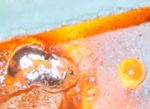
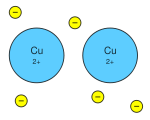
Copper has a high electrical and thermal conductivity, second only to silver among pure metals at room temperature.[6]
Copper is a reddish-coloured metal; it has its characteristic colour because of its band structure. In its liquefied state, a pure copper surface without ambient light appears somewhat greenish, a characteristic shared with gold. When liquid copper is in bright ambient light, it retains some of its pinkish luster.
Copper occupies the same family of the periodic table as silver and gold, since they each have one s-orbital electron on top of a filled electron shell. This similarity in electron structure makes them similar in many characteristics. All have very high thermal and electrical conductivity, and all are malleable metals.
Corrosion
Pure water and air
Copper is a metal that does not react with water (H2O), but the oxygen of the air will react slowly at room temperature to form a layer of copper oxide on copper metal.
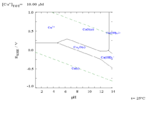
It is important to note that in contrast to the oxidation of iron by wet air that the layer formed by the reaction of air with copper has a protective effect against further corrosion. On old copper roofs a green layer of copper carbonate can often be seen.
Sulfide media
Copper metal does react with hydrogen sulfide and sulfide containing solutions. A series of different copper sulfides can form on the surface of the copper metal.

Note that the copper sulfide area of the plot is very complex due to the existence of many different sulfides, a close up is also provided to make the graph more clear. It is clear that the copper is now able to corrode even without the need for oxygen as the copper is now less noble than hydrogen. This can be observed in every day life when copper metal surfaces tarnish after exposure to air which contains sulfur compounds.
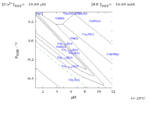
Ammonia media
Copper does react with oxygen-containing ammonia solutions because the ammonia forms water-soluble copper complexes. The formation of these complexes causes the corrosion to become more thermodynamically favored than the corrosion of copper in an identical solution that does not contain the ammonia.
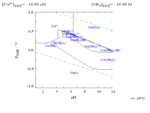
Chloride media
Copper does react with a combination of oxygen and hydrochloric acid to form a series of copper chlorides. It is interesting to note that if copper(II) chloride (green/blue) is boiled with copper metal (with little or no oxygen present) then white copper(I) chloride will be formed.
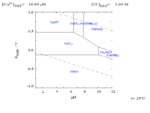
Mechanical Properties
A single crystal copper consists of a few microns of small crystals. In this form of crystal (c), the yield stress is high and crystal undergoes a large amount of elastic deformation before going into the plastic deformation region. The plastic deformation region has an unpredictable outcome. The stress level decreases significantly as necking begins to occur.
Polycrystal copper has many crystal of different geometries combined. The plastic deformation of polycrystal is similar to mild steel. Copper has a high ductility and will continue to elongate as stress is applied. It is very useful in copper wire drawing.
Numerous copper alloys exist, many with important historical and contemporary uses. Speculum metal and bronze are alloys of copper and tin. Brass is an alloy of copper and zinc. Monel metal, also called cupronickel, is an alloy of copper and nickel. While the metal "bronze" usually refers to copper-tin alloys, it also is a generic term for any alloy of copper, such as aluminium bronze, silicon bronze, and manganese bronze.
Germicidal effect
Copper is germicidal, via the oligodynamic effect. For example, brass doorknobs disinfect themselves of many bacteria within a period of eight hours.[8] This effect is useful in many applications.
Occurrence and modern industry
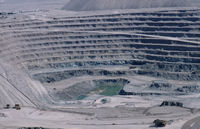


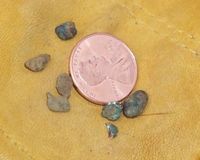
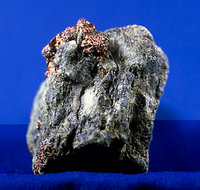
In 2005, Chile was the top mine producer of copper with at least one-third world share followed by the USA, Indonesia and Peru, reports the British Geological Survey.
Copper can be found as native copper in mineral form. Minerals such as the sulfides: chalcopyrite (CuFeS2), bornite (Cu5FeS4), covellite (CuS), chalcocite (Cu2S) are sources of copper, as are the carbonates: azurite (Cu3(CO3)2(OH)2) and malachite (Cu2CO3(OH)2) and the oxide: cuprite (Cu2O).
Most copper ore is mined or extracted as copper sulfides from large open pit mines in porphyry copper deposits that contain 0.4 to 1.0 percent copper. Examples include: Chuquicamata in Chile and El Chino Mine in New Mexico. The average abundance of copper found within crustal rocks is approximately 68 ppm by mass, and 22 ppm by atoms.
The Intergovernmental Council of Copper Exporting Countries (CIPEC), defunct since 1992, once tried to play a similar role for copper as OPEC does for oil, but never achieved the same influence, not least because the second-largest producer, the United States, was never a member. Formed in 1967, its principal members were Chile, Peru, Zaire, and Zambia.
The copper price has quintupled from the 60-year low in 1999, rising from US$0.60 per pound in June 1999 to US$3.75 per pound in May 2006, where it dropped to US$2.40 in February 2007 then rebounded to US$3.50 in April 2007.[9]
The Earth has an estimated 61 years of copper reserves remaining.[10] Environmental analyst, Lester Brown, however, has suggested copper might run out within 25 years based on a reasonable extrapolation of 2% growth per year.[11]
Compounds
Common oxidation states of copper include the less stable copper(I) state, Cu+; and the more stable copper(II) state, Cu2+, which forms blue or blue-green salts and solutions. Under unusual conditions, a 3+ state and even an extremely rare 4+ state can be obtained. Using old nomenclature for the naming of salts, copper(I) is called cuprous, and copper(II) is cupric. In oxidation copper is mildly basic.
Copper(II) carbonate is green from which arises the unique appearance of copper-clad roofs or domes on some buildings. Copper(II) sulfate forms a blue crystalline pentahydrate which is perhaps the most familiar copper compound in the laboratory. It is used as a fungicide, known as Bordeaux mixture.
There are two stable copper oxides, copper(II) oxide (CuO) and copper(I) oxide (Cu2O). Copper oxides are used to make yttrium barium copper oxide (YBa2Cu3O7-δ) or YBCO which forms the basis of many unconventional superconductors.
- Copper(I) compounds: copper(I) chloride, copper(I) bromide, copper(I) iodide, copper(I) oxide.
- Copper(II) compounds: copper(II) acetate, copper(II) carbonate, copper(II) chloride, copper(II) hydroxide, copper(II) nitrate, copper(II) oxide, copper(II) sulfate, copper(II) sulfide, copper(II) tetrafluoroborate, copper(II) triflate.
- Copper(III) compounds, rare: potassium hexafluorocuprate (K3CuF6)
- Copper(IV) compounds, extremely rare: caesium hexafluorocuprate (Cs2CuF6)
Tests for copper(II) ion
Add aqueous sodium hydroxide. A blue precipitate of copper(II) hydroxide should form.
Ionic equation:
- Cu2+(aq) + 2OH−(aq) → Cu(OH)2(s)
The full equation shows that the reaction is due to hydroxide ions deprotonating the hexaaquacopper (II) complex:
- [Cu(H2O)6]2+(aq) + 2 OH−(aq) → Cu(H2O)4(OH)2(s) + 2 H2O (l)
Adding aqueous ammonia causes the same precipitate to form. It then dissolves upon adding excess ammonia, to form a deep blue ammonia complex, tetraamminecopper(II).
Ionic equation:
- Cu(H2O)4(OH)2(s) + 4 NH3(aq) → [Cu(H2O)2(NH3)4]2+(aq) + 2H2O(l) + 2 OH−(aq)
A more delicate test than the ammonia is the ferrocyanide of potassium, which gives a brown precipitate with copper salts.
Applications
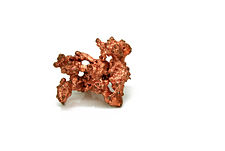
Copper is malleable and ductile, a good conductor of heat and, when very pure, a good conductor of electricity.
The purity of copper is expressed as 4N for 99.99% pure or 7N for 99.99999% pure. The numeral gives the number of nines after the decimal point when expressed as a decimal (e.g. 4N means 0.9999, or 99.99%).
It is used extensively, in products such as:
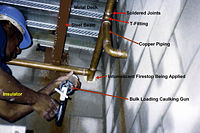
Piping
- including, but not limited to, extreme water supply.
Electronics
- Copper wire.
- Electromagnets.
- Printed circuit boards.
- Lead free solder, alloyed with tin.
- Electrical machines, especially electromagnetic motors, generators and transformers.
- Electrical relays, electrical busbars and electrical switches.
- Vacuum tubes, cathode ray tubes, and the magnetrons in microwave ovens.
- Wave guides for microwave radiation.
- Integrated circuits, increasingly replacing aluminium because of its superior electrical conductivity.
- As a material in the manufacture of computer heat sinks, as a result of its superior heat dissipation capacity to aluminium.
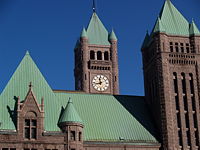
Architecture
- Copper has been used as water-proof roofing material since ancient times, giving many old buildings their greenish roofs and domes. Initially copper oxide forms, replaced by cuprous and cupric sulfide, and finally by copper carbonate. The final carbonate patina is highly resistant to corrosion.[12]
- Statuary: The Statue of Liberty, for example, contains 179,220 pounds (81.3 tonnes) of copper.
- Alloyed with nickel, e.g. cupronickel and Monel, used as corrosive assistant materials in shipbuilding.
- Watt's steam engine.
- Copper nails were used in making oast cowls.
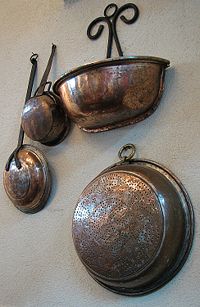
Household products
- Copper plumbing fittings and compression tubes.
- Doorknobs and other fixtures in houses.
- Roofing, guttering, and rainspouts on buildings.
- In cookware, such as frying pans.
- Most flatware (knives, forks, spoons) contains some copper (nickel silver).
- Sterling silver, if it is to be used in dinnerware, must contain a few percent copper.
- Copper water heating cylinders
Coinage
- As a component of coins, often as cupronickel alloy.
- Coins in the following countries all contain copper: European Union (Euro),[13] United States,[14] United Kingdom (sterling),[15] Australia[16] and New Zealand.[17]
- Ironically, U.S. Nickels are 75.0% copper by weight and only 25.0% nickel.[14]
Biomedical applications
- As a biostatic surface in hospitals, and to line parts of ships to protect against barnacles and mussels, originally used pure, but superseded by Muntz Metal. Bacteria will not grow on a copper surface because it is biostatic. Copper doorknobs are used by hospitals to reduce the transfer of disease, and Legionnaires' disease is suppressed by copper tubing in air-conditioning systems.
- Copper(II) sulfate is used as a fungicide and as algae control in domestic lakes and ponds. It is used in gardening powders and sprays to kill mildew.
- Copper-62-PTSM, a complex containing radioactive copper-62, is used as a Positron emission tomography radiotracer for heart blood flow measurements.
- Copper-64 can be used as a Positron emission tomography radiotracer for medical imaging. When complexed with a chelate it can be used to treat cancer through radiation therapy.
Chemical applications
- Compounds, such as Fehling's solution, have applications in chemistry.
- As a component in ceramic glazes, and to color glass.
Other
- Musical instruments, especially brass instruments and cymbals.
- Class D Fire Extinguisher, used in powder form to extinguish lithium fires by covering the burning metal and performing similar to a heat sink.
- Textile fibers to create antimicrobial protective fabrics.[18]
Biological role
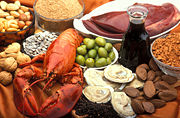
Copper is essential in all plants and animals. Copper is carried mostly in the bloodstream on a plasma protein called ceruloplasmin. When copper is first absorbed in the gut it is transported to the liver bound to albumin. Copper is found in a variety of enzymes, including the copper centers of cytochrome c oxidase and the enzyme superoxide dismutase (containing copper and zinc). In addition to its enzymatic roles, copper is used for biological electron transport. The blue copper proteins that participate in electron transport include azurin and plastocyanin. The name "blue copper" comes from their intense blue color arising from a ligand-to-metal charge transfer (LMCT) absorption band around 600 nm.
Most molluscs and some arthropods such as the horseshoe crab use the copper-containing pigment hemocyanin rather than iron-containing hemoglobin for oxygen transport, so their blood is blue when oxygenated rather than red.[19]
It is believed that zinc and copper compete for absorption in the digestive tract so that a diet that is excessive in one of these minerals may result in a deficiency in the other. The RDA for copper in normal healthy adults is 0.9 mg/day. On the other hand, professional research on the subject recommends 3.0 mg/day.[20] Because of its role in facilitating iron uptake, copper deficiency can often produce anemia-like symptoms.
Toxicity
All copper compounds, unless otherwise known, should be treated as if they were toxic. Thirty grams of copper sulfate is potentially lethal in humans. The suggested safe level of copper in drinking water for humans varies depending on the source, but tends to be pegged at 1.5 to 2 mg/L. The DRI Tolerable Upper Intake Level for adults of dietary copper from all sources is 10 mg/day. In toxicity, copper can inhibit the enzyme dihydrophil hydratase, an enzyme involved in haemopoiesis.Template:Facts
Symptoms of copper poisoning are very similar to those produced by arsenic. Fatal cases are generally terminated by convulsions, palsy, and insensibility.Template:Facts
In cases of suspected copper poisoning, Ovalbumin is to be administered in either of its forms which can be most readily obtained, as milk or whites of eggs. Vinegar should not be given. The inflammatory symptoms are to be treated on general principles, and so are the nervous.Template:Facts
A significant portion of the toxicity of copper comes from its ability to accept and donate single electrons as it changes oxidation state. This catalyzes the production of very reactive radical ions such as hydroxyl radical in a manner similar to fenton chemistry.[21] This catalytic activity of copper is used by the enzymes that it is associated with and is thus only toxic when unsequestered and unmediated. This increase in unmediated reactive radicals is generally termed oxidative stress and is an active area of research in a variety of diseases where copper may play an important but more subtle role than in acute toxicity.
An inherited condition called Wilson's disease causes the body to retain copper, since it is not excreted by the liver into the bile. This disease, if untreated, can lead to brain and liver damage. In addition, studies have found that people with mental illnesses such as schizophrenia had heightened levels of copper in their systems. However it is unknown at this stage whether the copper contributes to the mental illness, whether the body attempts to store more copper in response to the illness, or whether the high levels of copper are the result of the mental illness.Template:Facts
Too much copper in water has also been found to damage marine life. The observed effect of these higher concentrations on fish and other creatures is damage to gills, liver, kidneys, and the nervous system. It also interferes with the sense of smell in fish, thus preventing them from choosing good mates or finding their way to mating areas.Template:Facts
Miscellaneous hazards
The metal, when powdered, is a fire hazard. At concentrations higher than 1 mg/L, copper can stain clothes and items washed in water.
See also
- Acierage
- Cold Water Pitting of Copper Tube
- Copper extraction techniques
- Erosion Corrosion of Copper Water Tubes
- Operation Tremor
- Smelter
- Native Copper
- Anaconda Copper
Further reading
- "Copper: Technology & Competitiveness (Summary) Chapter 6: Copper Production Technology". Office of Technology Assessment. 2005.
- Current Medicinal Chemistry, Volume 12, Number 10, May 2005, pp. 1161-1208(48) Metals, Toxicity and Oxidative Stress
- William D. Callister (2003). Materials Science and Engineering: an Introduction, 6th Ed. Table 6.1 p137.: Wiley, New York. ISBN 0471736961.
- Material: Copper (Cu), bulk, MEMS and Nanotechnology Clearinghouse.
External links
- National Pollutant Inventory - Copper and compounds fact sheet
- Copper Resource Page. Includes 12 PDF files detailing the material properties of various kinds of copper, as well as various guides and tools for the copper industry.
- The Copper Development Association has an extensive site of properties and uses of copper; it also maintains a web site dedicated to brass, a copper alloy.
- The Third Millennium Online page on Copper
- The WebElements page on Copper
References
- ↑ Richard Cowen, Essays on Geology, History, and People, Chapter 3: "Fire and Metals: Copper".
- ↑ harappa.com (Web archive)
- ↑ Thomas C. Pleger, Ph.D. (2000). "The Old Copper Complex of the Western Great Lakes". UW-Fox Valley Anthropology. Retrieved 2007-08-15.
- ↑ O’Brien, W. (1997). Bronze Age Copper Mining in Britain and Ireland. Shire Publications Ltd. ISBN 0747803218.
- ↑ Timberlake and Prag, 2005
- ↑ Los Alamos National Laboratory - Copper
- ↑ 7.0 7.1 7.2 7.3 7.4 Ignasi Puigdomenech, Hydra/Medusa Chemical Equilibrium Database and Plotting Software (2004) KTH Royal Institute of Technology, freely downloadable software at [1]
- ↑ Phyllis J. Kuhn, Ph.D. (1983). "Doorknobs: A Source of Nosocomial Infection?". Retrieved 2007-08-15.
- ↑ Copper Trends: Live Metal Spot Prices, MetalSpotPrice.com
- ↑ New Scientist. May 26, 2007.
- ↑ Brown, Lester (2006). Plan B 2.0: Rescuing a Planet Under Stress and a Civilization in Trouble. New York: W.W. Norton. p. 109. ISBN 0393328317.
- ↑ Berg, Jan. "Why did we paint the library's roof?". Retrieved 2007-09-20.
- ↑ Copper Development Association, UK
- ↑ 14.0 14.1 US Mint specifications.
- ↑ Royal (i.e. United Kingdom) Mint specifications.
- ↑ Royal Australian Mint specifications.
- ↑ Change For The Better/Q & A/Technical Questions
- ↑ Cupron Antimicrobial
- ↑ Horseshoe Crab Fun Facts NOAA and Univ. of Delaware
- ↑ National Research Council. Copper. In: Recommended Dietary Allowances. Washington, D.C.: Food Nutrition Board, NRC/NAS, 1980: 151-154.
- ↑ Held KD; et al. (May 1996). "Role of Fenton chemistry in thiol-induced toxicity and apoptosis". Radiat Res. 145 (5): 542–53.
af:Koper ar:نحاس ay:Anti az:Mis bn:তামা zh-min-nan:Cu (goân-sò͘) be:Медзь be-x-old:Медзь bs:Bakar bg:Мед (елемент) ca:Coure cv:Пăхăр cs:Měď co:Ramu cy:Copr da:Kobber de:Kupfer et:Vask el:Χαλκός eo:Kupro eu:Kobre fa:مس fur:Ram ga:Copar gd:Copar gl:Cobre (elemento) gu:તાંબુ ko:구리 hy:Պղինձ hi:ताम्र hr:Bakar (element) io:Kupro id:Tembaga is:Kopar it:Rame he:נחושת ka:სპილენძი kw:Kober sw:Shaba kg:Mutako ht:Kuiv ku:Mis la:Cuprum lv:Varš lb:Koffer lt:Varis li:Koper jbo:tunka hu:Réz mk:Бакар ml:ചെമ്പ് mi:Konukura mr:तांबे ms:Tembaga mn:Зэс nah:Chīltic tepoztli nl:Koper (element) no:Kobber nn:Kopar oc:Coire uz:Mis nds:Kopper (Metall) ksh:Koffer (Metall) qu:Anta sq:Bakri scn:Rami simple:Copper sk:Meď sl:Baker sr:Бакар sh:Bakar fi:Kupari sv:Koppar ta:செப்பு te:రాగి th:ทองแดง tg:Мис uk:Мідь ur:تانبا yi:קופער zh-yue:銅